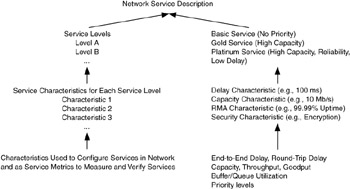1.7 Service Description
1.7 Service Description
The concept of network services in this book builds upon the services work from the IETF. This organization has been developing service descriptions for IP networks. In general, they see network services as sets of network capabilities that can be configured and managed within the network and between networks. We apply this concept to network analysis, architecture, and design, integrating services throughout the entire system. This will help you take advantage of the services concept by analyzing, architecting, and designing based on services, and it will also prepare you for the near future, when services will be configurable and manageable within the network.
Network services, or services, are defined here as levels of performance and function in the network. We can look at this from two perspectives: as services being offered by the network to the rest of the system (the devices, applications, and users) or as sets of requirements from the network that are expected by the users, applications, or devices. Levels of performance are described by the performance characteristics capacity, delay, and RMA (reliability, maintainability, and availability), whereas functions are described as security, accounting, billing, scheduling, and management (and others). This will be described in more detail in the next section.
It is important to note that the concept of services in this book is based on what networks can deliver to the system. Thus, it is not to be confused with services that other parts of the system (e.g., applications) can deliver to each other (e.g., graphics rendering services). When the term service is used in this book, it is in reference to network service.
Network services in most of today's networks are based on best-effort (unpredictable and unreliable) delivery. In addition to best-effort delivery, we will examine some new types of services, including high-performance, predictable (stochastic or probabilistic), and guaranteed services. These new services will require some different ways of looking at networks, and you will see how to incorporate such services into your architecture and design. We will also examine single-tier and multiple-tier performance in the network, how to distinguish between them, and how they relate to best-effort, predictable, and guaranteed services.
Network services are hierarchical, and individual service characteristics can be grouped together to form higher-level descriptions of a service, as shown in Figure 1.18.

Figure 1.18: Grouping characteristics into service levels and descriptions.
EAN: 2147483647
Pages: 161